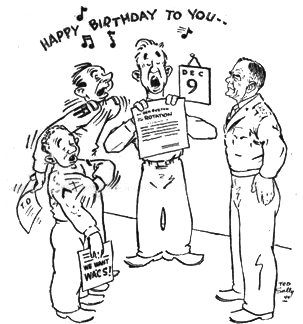
VOL. III NO. 14 REG NO. L5015 DELHI, THURSDAY DECEMBER 14, 1944
GEN. SULTAN'S HQ., NORTH BURMA - Major General Frederick W. Festing's British 36th Division, under the command of Lt. Gen. Dan I. Sultan, this week occupied Katha, encountering no Japanese opposition.
Earlier the british forces moved through the town of Naba and Naba Junction and took the town of Indaw, which also was occupied without opposition.
After the occupation of Indaw, 36th Division patrols moved east from the junction toward Kathaw, where the main railway branches toward Katha. These patrols did not encounter any Japs, in their seven-mile advance on Naba Station from Pinwe, the British troops did not meet with any oppostion from the enemy.
This occupation of Katha makes a total of about 115 miles' advance since the 36th Division started near Mogaung on Aug. 1. Clearing of Naba Junction enabled the British to split and move east to the important river town of Katha, which is about 70 miles along the Irrawaddy south and west of Bhamo.
At Bhamo, which is less than 60 miles east of Katha in a straight line, Chinese 38th Division troops in that area made slight gains in the northern sector along the river on the basis of latest reports.
Occupation of Katha places the British troops approximately 155 miles north of Mandalay and only about 60 miles from 14th Army troops who crossed the Sittang several days ago.
On the Salween front Chinese troops have fanned out from Chefang to within 15 miles of Wanting. A Chinese force bypassing Bhamo is racing to effect a junction with these troops. Meanwhile, a third Chinese force has driven a 40-mile wedge southward between Bhamo and the railway corridor, through which British troops have been operating.
DEPUTY CG MERRILL
Maj. Gen. Frank D. Merrill, former commander of Merrill's Marauders, was made deputy commander of United States Forces in the India-Burma Theater this week, Theater headquarters announced.
Br. Gen. Vernon Evans was moved up from deputy chief of staff to Lt. Gen. Dan I. Sultan to chief of staff.
Col. Dean Rusk was announced as deputy chief of staff to fill the place formerly occupied by Evans. Rusk formerly served as assistant chief of staff.
WASHINGTON (UP) - Debits and credits in the American ledger of war were revealed by the War Department on Pearl Harbor Day in an accounting of the nation's gains and losses after three years of conflict.
As the United States entered its fourth year of strife, the cost side of the American balance sheet revealed:
Casualties: 552,018, of which 121,363 were killed. Casualties for the Army were 474,898, including 91,625 killed, 268,099 wounded, 58,926 missing and 56,248 prisoners. Casulaties for the Navy, Marine Corps and Coast Guard were 77,120, including 29,738 dead, 34,469 wounded, 9,427 missing and 4,486 prisoners.
THE BREAKDOWN
Ships: U.S. warships sunk,229. Merchant ships sunk through 1943, 753. Planes: Lost, 13,491.
Public debt: The public debt has risen to $224,600,000,000.
The War Department showed the following on the credit side of the ledger:
Military personnel: The Army's personnel has increased from 1,600,000 to 8,000,000 and the Navy has increased from 430,000 to 3,800,000.
OUR PRODUCTION
Ships: U. S. ships have increased from 1,076 to 56,270. Two thousand three hundred enemy ships have been destroyed, including 360 Jap warships. Planes: Thirty-seven thousand enemy planes have been destroyed and 204,000 American planes were produced in the three-year period.
Tanks and guns: Seventy thousand tanks were produced and 2,700,000 big and medium guns.
Territory libersted for the Allies: North Africa, France, Belgium, Luxemburg, Greece and most of Italy and Yugoslavia, Russia, and 8,170,00 square miles of the Pacific area.
ENEMY COST
Enemy casualties: Seven hundred and fifty thousand germans captured, some 500,000 others killed or wounded; 277,000 Japs killed, another 250,000 marooned.
General situation: Transition from a war of desperate defense to one of confident attack and victory.
At the same time, Undersecretary of War Robert P. Patterson disclosed the use of men under 19 for the Army. He explained that exigencies of the military situation and lack of enough suitable older replacements accounted for this reversal of Army policy.
CASAC EARN 14TH AF DEMOLITION TITLE
EAST CHINA U.S. AIR BASE - Driving down a mined runway, jumping out to pull the hand fuse of a 1,000 pound bomb, hiring 1,000 Chinese workers in a hurry to clear the field of Jap bomb fragments to keep the operations going.
These are some of the "unspectacular" jobs of the East China sector of the China Air Service Area Command (CASAC), which, like other service forces, is cloaked in the anonymity of hard work, sweat and little glamour. These and other more routine jobs of the CASAC help keep Maj. Gen. Claire L. Chennault's 14th AF "Flying Tigers" flying and hitting the Japs.
When the Japs launched their powerful offensive in China last May, gasoline, bomb, and ammunition demands reached a high level. Against the enemy threat the 14th mounted an all-out day and night attack. It was an acid test period for CASAC's eastern sector.
SECTOR HEAD
Sector commander was Col. Richard H. Wise, a 1931 graduate of West Point and former Air Inspector of the Eastern Flying Training Command in the U.S.
He had to meet with a minimum of personnel the service requirements of an air force carrying out large-scale operations, while being forced by the retreat of the ground forces to blow up base after base and withdraw to other fields not yet in danger.
CASAC co-ordinated with the 14th's A-4, SOS, Transportation Corps and the 14th Transport Section in the movement of critical items from threatened bases to the rear and to other unprecedented demand for incoming supplies.
PLAN EVACUATION
In co-operation with the Tactical Air Force, the CASAC base commanders planned and supervised the evacuation of personnel and materiel and the mining of seriouslt threatened bases. They carried on with skeleton crews as long as the fields were used tactically.
When operations ceased they carried out the orders of Brig. Gen. Clinton D. Vincent to burn and blow the bases and withdraw. One base commander, Lt. Norwood Wilson, directed the destruction of Hengyang bases and withdrew to Lingling. Then he destroyed Lingling and fell back to Kweilin, where he was demolition officer for the base there.
ADMINISTRATIVE SHARE
Another base commander, Capt. Earl D. Gibbons, demolished the Paoching base. He was set to Tanchuk and afterwards directed its demolition.
The administrative officers also had their headaches. While the enemy was chewing off the sector piece by piece orders had to be changed many times to keep abreast of developments. Men in the field had no time to make shipping orders in quadruplicate; records were burned.
But officers like Lt. Edward Cabelka and Lt. James F. Willet, managed to keep the records straight. They accounted for everything - down to the last pint of gas.
|
CHAMPAGNE - AGAIN !
ALONG THE LEDO ROAD - "Aw, gee, champagne again." Such is the disgruntled comment as chilled bottles of sparkling giggle wine are served to Pvts. John F. Wallace and Arthur A. Brown. Wallace and Brown, suffering combat wounds are recuperating at a large general hospital along the Ledo Road.
To tone up sluggish appetites after a long siege abed, the two mending G.I.'s are furnished a regular diet of champagne. Envious glances and drooling mouths respond to the popping corks and happy gurgle of the whoppee water, but to the old imbibers, Wallace and Brown, it's just another item in the battle to gain weight.
As the unwilling pair settle back to partake of the magic vino, they hurl protests like, "I'd rather have a strawberry coke" or "I'm sick of champagne." this is met with a chorus of sighs, longing looks and enthusiastic offers to help dispose of the "medicine."
"Just proves you can't have everything," one recuperating jungle wallah observed. "If you have an appetite, you don't get it, If you haven't, you don't want it." The sage turned over in his hospital sack as Wallace and Brown screw up their faces for their daily champagne ordeal.
AIR STRIP EXPERIMENT
GEN. SULTAN'S HQ., BURMA - It began like a Broadway premiere. A press officer of the 10th Air Force dropped in with the invitation. His proposition was quaint. Your correspondent was invited to first-land with a C-47 on a new jungle strip where only liaison planes landed before. If all went smoothly the strip would be declared open for cargo planes; if we crack, they would have to wait, I was told.
next morning we jeeped to the Myitkyina airport and boarded the lovliest C-47 I ever rode. From her nose smiled the multi-colored image of a buxom blonde, with a fish tail. An arc of the gilded letters The Virgin Sturgeon skirted the fish wench.
OVER BHAMO
The ship's door was stripped from its frame and we rolled in a jeep. Followed the premiere party led by Col. Manuel J. Asensio, who was to declare the field open. In the party were also Maj. Phillip Boyer, EAC, who wrote in civilian life for the New York Herald Tribune; Sgt. Charles V. Hamilton, and Cpl. Ray Novicki, both 10th Air Force photographers.
The pleasant sensation of curious expectation, so often felt before a theater premeire, animated everyone. But sober and serious seemed Lts. John Segelquist, a combat cargo pilot, and Robert Houchin, the pilot and co-pilot, who had to shoulder success or failure of the event.
In the last minute we were joined by Lts. Walter Black and Garret Wood, a two-headed gravel reconnaissance team of the 10th. The gentlemen had an important share in the show. In search for the best combination of local gravel and clay to build an all-weather strip. Chinese aviation engineers walked miles through sniperful jungle country. They examined, for instance, the Bhamo airstrip in the midst of the battle for Bhamo. They did this by joining a Chinese regiment in the storming of the strip and by crawling into a revetment for their soil test. The field, by the way, was partly still in enemy hands while this was written.
The lieutenants pursued a new policy of their air force to build our strips at the moment the enemy decides to hold a position. This wins immeasurable precious time. Almost the very hour a stronghold is captured, we have the supplies flown in to capture the next. In case the enemy clings too stubbornly to a position, we bypass it for the time being and build a field in his backyard. This, for example, has been achieved at the field The Virgin Sturgeon was going to test. True, we have built airstrips behind the enemy's forward positions during past campaigns, but we have never intensified these efforts to the present efficiency. Last summer it took us almost a month to ready one strip for cargo planes. This time the field in the "Railway Corridor" which supports the British 36th Division in its drive to Mandalay, was built in 48 working hours. The ready strip was able to receive 38 cargo planes in a single day. The new field east of Bhamo, which we were going to test, was completed as a Cub strip in a day and only another day and a half were needed to streamline it for combat cargo.
While the Virgin winged southward I sat in its open door frame and watched the countryside in oversized picture-postcards flying by. Right over Bhamo a P-47 was bombing and strafing enemy positions. She did a good job. Every bomb seemed to explode at the right spot. Whole buildings were simply taking the air. And there we were, a low-flying unarmed cargo plane, enjoying the spectacle of action. No Jap fighters, no Jap ack-ack, not even a single rifle shot to interfere.
Our absolute air supremacy most probably will outlast the present campaign. Only on the ground, dug in unto death, is the enemy opposing. But even these ferocious suicide stands cannot break up our inevitable advance. It was observed recently that one well-placed bomb destroyed 400 Japanese small arms. At another point our bombardments took such a toll of motor tranports that the Japs had to destroy a great deal of their supplies during their retreat southward. Japanese administration has been broken down at many places because of the terrific pounding by the 10th Air Force. The Jap was forced to move, to fight only at night when he can reap the advantages of concealment and cover.
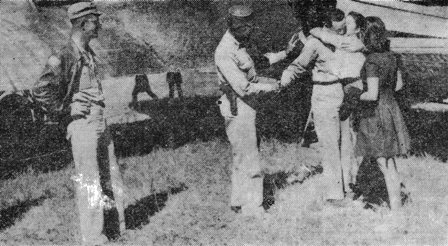 Col. W. J. Asensio, 10th Air Force Engineer officer and Lt. Col. New Burns watch the struggle as Combat Cargo Pilot
Lt. John Segelquist is greeted by Elsie Turner, a local gal, after landing the first transport at advanced Burma base.
Nellie Turner, a sister, also views the proceedings.
Col. W. J. Asensio, 10th Air Force Engineer officer and Lt. Col. New Burns watch the struggle as Combat Cargo Pilot
Lt. John Segelquist is greeted by Elsie Turner, a local gal, after landing the first transport at advanced Burma base.
Nellie Turner, a sister, also views the proceedings.
|
Enjoying these unpleasant predictaments of our enemies, we faced the test landing in a very carefree mood. The strip below us was carved out of a paddy field. We held our breath. With a swift swan dive, the aircraft swept down to earth and rolled across the new strip, hit a bad soft spot, and then was safely down.
Lt. Col. Newman Burns, our chief liaison officer with the Chinese 38th Division and godfather of all Americans in the area, appeared very pleased. So were his staff officers. So were the 26 Aviation Engineers who were flown in a few days ago by liaison planes to streamline the strip. And particularly jubilant was Elsie Turner, a 16-year-old Shan, and nellie, a younger sister. The girls' family owns the ex-paddy-field which became our new airstrip. Conscious of this, they welcomed us will all the grace of charming young hostesses. Elsie's white silken Burma blouse carried buttons of gold and jade. Her long, printed skirt was wrapped with worldly elegance around her slender figure.
Intersting too, was her case history. Her father was a forestry official who married a beautiful girl in North Burma. This is why the daughter carries a double name. When she wears Western clothes, she calls herself Elsie Turner, but now she was Ma Thein Nijo. In peace time she used to live in Bhamo and never ventured farther than Mandalay. The Japanese caught up with her when she was fleeing Bhamo for this village. They confined her along with all the other English speaking native people. Miss Turner's confinement lasted 10 months. The Japs, according to their policy in this district, treated her with impeccable politeness. She could keep everything she possessed, all the family jewels of gold, rubies and jade.
BACK TO WORK
As soon as the excitement of the welcome died down, everybody went back to work and the landscape regained the look of war. The Aviation Engineers, who knocked the rice paddy ditches down and superimposed the strip, were now busy filling the tracks The Virgin Sturgeon left behind. S/Sgt. Leonard Packwas was supervising a gang of G.I.'s carrying fresh soil on burlap stretchers to the field. There, Pfcs. Raymond Johnson and Richard Trally were tamping the new earth into the furrows.
Our strip was now a complete fair-weather field. If streamlined to all-weather, and entire battalion of Aviation Engineers will have to be flown in. The jeep we brought with us will aid a new gravel reconnaissance team to find building material for the next trip.
The Aviation Engineers are doing an exceedingly good job by planting their strips all round the enemy. And they are very sensitive about not being referred to as the Airborne Engineers. The Airbornes Engineers, something else again, were equipped to be airborne. They carry midget airborne equipment into the field, while the Aviation Engineers work with materiel never designed to be airborne. They became airborne by necessity when there was a lack of roads. One of the biggest pieces of equipment used by an Airborne Engineer battalion weighs two-and-a-half tons. Aviation Engineers carry pieces weighing 16 tons. It happened during the Myitkyina campaign, when for the first time, a complete Aviation Engineer battalion and its extra heavy equipment was moved by air in any theater.
SUPER-FORTS CAUSE OF JAPAN QUAKE?
NEW YORK - A violent eartquake, described as the greatest shock since 1923, shook Japan proper this week on the third anniversary of Pearl Harbor, causing huge landslides, large tidal waves and caving in streets in the Tokyo and Yokohama area.
Twenty-four hours after seismograph stations in Switzerland, Britain, India and America reported extremely high land tremors in the area of Japan, the official Japanese new agency, Domei, acknowledged that an earthquake centered about 120 miles at sea, had rolled up great tidal waves and started landslides through central Japan.
GREATER THAN '23
Seismologists around the world agreed that the shock might well be even greater than the one which rocked Japan in 1923, when 100,000 lives were lost, but believed it would not affect their war effort to any great extent.
Dr. L. Don Leet, of Harvard University, said the quake was undoubtedly "big, but a first-class B-29 raid" could do more damage "any day." "They've had others," he said, "but are still holding together at the seams."
Reports of the quake caused immediate speculation as to whether recent B-29 raids were responsible. Dr. Harold O. Whitnall, Colgate University geoligist, maintained that Super-Fort bombings might possibly cause earthquakes and tidal waves.
THEORY SUPPORT
To support his theory, Whitnall pointed out: "Soon after the Doolittle raid, Mt. Asama erupted. In March 1943, after our fliers had given the surrounding area a terrific pounding, Mt. Vesuvius erupted. Now, an earthquake and tidal waves, of the type I said could be produced by bombing, have occurred after repeated attacks on Japan. Such a chain of coincidences seems, at least, strong circumstantial evidence."
Whitnall's theory was discounted, however, by Rev. Joseph J. Lynch, seismologist at Fordham University, who said "it was impossible that bombs could have caused the quake."
"The effect of a bomb compared with the effect of an earthquake," he declared, "is as a flea compared to an elephant," adding that the bombing would not increase the chemical activity with causes volcanic disturbances.
7TH BOMB GROUP NOW IN 25TH YEAR
 Decorated for outstanding achievements in three years of war against the Japanese, this unit of the famed Seventh
Bombardment Group is shown against a background of the B-24 they operate from a base in the India-Burma Theater.
Thirty-six months of overseas service stripes show on the placque at center.
Decorated for outstanding achievements in three years of war against the Japanese, this unit of the famed Seventh
Bombardment Group is shown against a background of the B-24 they operate from a base in the India-Burma Theater.
Thirty-six months of overseas service stripes show on the placque at center.
|
HQ., 7TH BOMB GROUP - Members of the Seventh Bombardment Group this week are in their fourth year of jumping on the Japs and Germans after celebrating the Seventh's 25th year of activity and its third anniversary overseas.
One of the oldest air combat units in the Army Air Forces, this 10th Air Force group celebrated the dual anniversary with brief, simple ceremonies.
Maj. Gen. George E. Stratemeyer, commanding general of the Eastern Air Command, of which the Seventh is a unit, took part in the anniversary observance as a former commanding officer of the group. Col. Harvey T. Allness, present group commander, served in the Seventh under Stratemeyer.
Addressing the group at the ceremony, at which he presented medals to several officers and enlisted men, Stratemeyer pointed out that the Seventh Bombardment Group in its colorful career has s lutrous war-to-war history that "needs no polishing."
Stratemeyer said that he was proud to be a former member of the Seventh in his remarks to the assembled combat and ground crews.
"This group has had a long and honorable record. Some of its original units served with distinction in World War I, and since the outset of this conflict, units of the Seventh have battled the enemy in the Philippines, the Netherlands Indies, Java, the Middle East, China, Burma, Thailand and the Andaman Islands.
"To me, working with the Seventh was always a pleasure. Today, with many former members of the group in the Eastern Air Command, it is gratifying to see you carrying on the group's great traditions."
Men of the Seventh shared billets, bombs, and bullets with the famous 19th Bombardment Group in Java, and in June 1942, a unit of the group was among the force that helped to stop Field Marshal Rommel in the Middle East.
In the war against the Japanese, men of the Seventh have flown one of the world's longest combat missions, mor than 2,800 miles round-trip, from an inland base in India to Bangkok, Thailand. In addition, an all-over-water assignment from India to Car Nicobar Island totalled more than 2,000 miles.
When the Japanese attacked Pearl Harbor, one unit of the Seventh, unarmed, was arriving at Honolulu and circling the island during the attack.
The personnel list of the Seventh is far from being the original roster. The group has been strengthened in this theater by American Volunteer Group veterans as well as former members of the famed "Tokyo Raiders," who worked their way from China to India to join the group.
Flying B-24's mainly, the Seventh has hung up an enviable record in bombing operations that has helped flush the Japs from centers in Burma, and its operations have been of great value to the Allies in the bombing of Rangoon, Myitinge Bridge, Pyinnaus Railway Yards, Akyab, Bangkok, the Andaman Islands, and other targets.
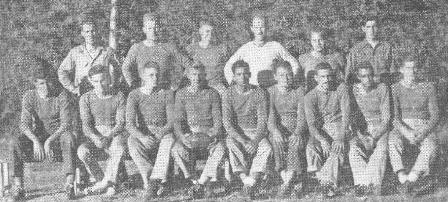
|
Men from all parts of the United States, now fighting in China, haven't forgotten how to play the American game of football. In the "Rice Bowl" game recently, members of the 14th Air Force team lost to the Ground Forces 12-0. Left to right: (Back Row) Pfc. William B. Deem, Marietta, Ohio; Sgt. John A. Hanna, Kansas City, Mo.; Cpl. Robert C. Hutchinson, Lake City, Tenn.; S/Sgt. Loyal R. Briggs (Coach), Warren, Penn.; Sgt. Carl F. Schenk, Rochester, N.Y.; Sgt. Charles K. Mette, Olean, N.Y. (Front Row) Sgt. Fred B. Heath, Jersey City, N.J.; Cpl. Roland J. Sikorski, Milwaukee, Wis.; Cpl. Ray W. Miller, Webster City, Iowa; Cpl. Joe Yovich (Captain), Wilkes Barre, Penn.; Sgt. Joe B. Valalik, Hamden, Conn.; Cpl. Peter Baktis, Brooklyn, N.Y.; Pfc. Walter J. Culberson, Tuscaloosa, Ala.; T/Sgt. Richard C. Miller, Craig, Neb.; Cpl. Jack W. Eslick, Fayetteville, Tenn.
Plane's Dive Douses Fire
CHINA - Lt. Curtis W. Mahannah, Mustang fighter pilot, was right in the thick of things in a recent dogfight, with two Zeros shot down and one damaged to his credit, when a Jap fighter got on his tail and set his P-51 afire.
Mahannah was all set to bail out, when the Nip pilot came in for another pass. Rather than jump over enemy country, and possibly be strafed in his 'chute, he nosed his ship over in a steep dive - and put the fire out, returning safely to base soon after with the damaged plane.
MALE SUPPLY BASE WRECKED BY EAC
EASTERN AIR COMMAND HQS. - P-47's and B-25's of Maj. Gen. George E. Stratemeyer's Eastern Air Command celebrated the third anniversary of Pearl Harbor by carrying out attacks on enemy troops, ammunition dumps, supply areas and bridges throughout Burma during the week.
The Jap supply center at Male, 75 miles north of Mandalay on the Irrawaddy River, was the first target of EAC fighter-bombers soon after dawn on Dec. 7. "More than half of Male was gutted by explosions," reported Maj. Morgan S. Tyler, commanding officer of the "Fighting Crows" squadron "and more than 30 tons of bombs were dropped by the P-47's.
 Marjorie White, whose shapely gams are on display above, is the sweetie-pie of the Postal Regulating Section of
APO 465. For reasons of their own, they callfs her "The girl we would most like to be tied up in a mail sack with."
Gad! What a waste of time that would be, Houdini!
Marjorie White, whose shapely gams are on display above, is the sweetie-pie of the Postal Regulating Section of
APO 465. For reasons of their own, they callfs her "The girl we would most like to be tied up in a mail sack with."
Gad! What a waste of time that would be, Houdini!
|
CONSTANT ATTACKS
The attacks on Male were so constant that some of the pilots, flying two and three sorties, were in their cockpits for over six hours without letup. So rapid was the turn-around, one pilot remarked, "I came back from one mission to be interrogated but got briefed for another sortie instead."
"The dust never had a chance to settle," said M/Sgt. O. M. DeWitt, who worked under Lt. W. T. Yahnkers in bombing up the returning planes. "Every time we opened our eyes, the dirt was still pouring into our faces and another plane was waiting to be bombed up again."
BRIDGE BUSTERS
When darkness fell, Mitchell bombers of the 490th "Bridge Busting" squadron, 10th Air Force, took up the attack, blasting enemy communications. One recent moonlight night, two B-25's, in a one hour and 25 minute flight, destroyed a locomotive and 12 railway wagons north of Tangon Bridge midway between Naba and Mandalay, started fires at the Meza Bridge and strafed several bridges and villages along the route.
Next night, the two Mitchells were out again for more than two hours, harrying Jap supply routes up and down the Burma Road, in and around Lashio and Kyaikthin. Twenty-five railway wagons were destroyed and an oil storage dump set afire.
AT KYAIKTHIN
At Kyaikthin, F/O Warren Mancke destroyed 12 railway wagons and heavily strafed a locomotive. A direct hit on an oil wagon started the entire string of wagons burning, which could be seen 85 miles away, according to Lt. Raymond George Kroker. After dropping its demolition and frag bombs, the bomber then strafed the railway yards, setting fire to a locomotive. More than 3,000 rounds of ammunition were used by the crew - Mancke, Kroker, Lt. Ernest Everson, Sgt. John C. Ligtvoet, engineer, Sgt. J. G. Miller, radio and gunner, and Sgt. Andrew Popowich, tail gunner.
The second B-25, which bombed the Burma Road at strategic points, was piloted by Lt. Ralph Everett and co-pilot Lt. William B. Plunkett. Lt. Stuart C. Clywck, was bombardier-navigator, S/Sgt. P. Kulesza, engineer-gunner, Sgt. Garry Eelman, tail gunner, and Sgt. R. Dick, radio operator-gunner.
Numerous other targets also felt the fury of EAC aircraft throughout the seven smashing days. RAF Libs bombed Khao-Haugang, southern tip of Burma; Hurribombers destroyed a bridge at Ye-u and another in the Arakan and strafed enemy ground troops on the Chindwin front; U.S. heavy bombers blasted the Burma-Siam railraod, starting huge fires, knocked out another bridge at Ketka; P-47's supported ground troops near Bhamo, strafing Jap forces and blowing up a nearby village; a combined EAC operation hit rolling stock on the Mandalay-Lashio route, blasted supply dumps at Kindaung on the Yo River at Tawgyin, Tilin and Lashio.
 Peaceful scene above, isn't it? Looks like a posed maneuvers shot. Actually, it was taken during the early parts
of the attack on Bhamo. A Chinese battalion commander is using a frontline trench as an OP. The Japs are about 200
yards away. In the background is the airstrip later captured by the Chinese. A photographer was wounded while these
pictures were being made.
Peaceful scene above, isn't it? Looks like a posed maneuvers shot. Actually, it was taken during the early parts
of the attack on Bhamo. A Chinese battalion commander is using a frontline trench as an OP. The Japs are about 200
yards away. In the background is the airstrip later captured by the Chinese. A photographer was wounded while these
pictures were being made.
|
 Newly appointed Brig. Gen. Robert Neyland is awarded the Legion of Merit by Maj. Gen. W. E. R. Covell, Commanding
General of SOS, I-B Theater. Neyland received the award for his outstanding work in China, where he headed SOS. A
recent transfer brought Neyland to Calcutta, where he now heads SOS.
Newly appointed Brig. Gen. Robert Neyland is awarded the Legion of Merit by Maj. Gen. W. E. R. Covell, Commanding
General of SOS, I-B Theater. Neyland received the award for his outstanding work in China, where he headed SOS. A
recent transfer brought Neyland to Calcutta, where he now heads SOS.
|
LIUCHOW JAPS HIT AS 14th AF STRIKES
Fighters and medium bombers of the 14th Air Force, supporting Chinese ground forces in South China during the past week, struck at enemy supply lines and troop concentrations between Hengyang and Liuchow in the Kweichow-Kwangsi railroad zone.
preparatory to its occupation by Chinese troops, Lipo, 20 miles southeast of Tushan, was bombed. Tushan also was bombed. Enemy cavalry in the Nantan area was bombed, and Chinese-American Wing Warhawks strafed enemy troops between Lingling and Liuchow.
HIT YUNGHENG
Striking three Japanese-controlled railroads over a 250-mile area in north and north-central China, Mustangs hit Yungheng on the Tung Pu railroad northeast of the Yellow River bend, destroying a gasoline and an ammunition dump. Railroad shops at Loyang on the Lung Hai railroad were bombed with good hits. They knocked out 600 feet of the Heishihkuan railroad bridge between Chenghsien and Loyang, bombed the steel works at Tayuan and the Lung Pu locomotive shops at Lin Fen. Fourteen locomotives were destroyed.
One mission of Mustangs against river shipping on the Yangtze sank a 200-foot freighter and a 100-foot launch, left a 175-foot freighter and a 75-foot cargo ship burning after damaging five and destroying three of 21 intercepting Oscars.
LIBS WORK
Liberators sank a 250-foot Jap freighter east of Shanghai, probably sank a 450-foot freighter and damaged another of the same length 120 miles west of the south tip of Formosa. Ten freighters were sunk, left sinking and damged on the Yangtze on the same date. Two freighters were damaged by strafing Mustangs at Amoy Harbor.
Jap military installations at Fort Bayard on the Liuchow Peninsula were bombed with good hits, heavy explosions following. Liberators bombed the Kowloon docks at Hong Kong and installations at Hamah Bay on Hainan Island.
Troop concentrations, troop trains, bridges, convoys and enemy columns were attacked in French Indo-China, Thailand, and on the Salween Front.
Six aircraft were reported by the week's communique as not returning to their base.
CHINESE SAY NIPS RETREAT IN KWEICHOW
The railway town of Shangsu, 18 miles south of newly captured Tushan in Kweichow Province, has been captured by Chinese troops who have turned back the enemy thrust directed at Kweiyang, the Chinese high command announced in Chungking this week.
Tushan has been cleared of enemy remnants, and "pursuing operations to the south are continuing," the high command reported.
HELD TUSHAN
Shangsu is 82 miles southeast of Kweiyang, the provincial capital, and is less than five miles from the border of Kwangsi Province. The Japanese reportedly held Tushan for four days. Chinese troops also have regained the highway town of Pachai, 65 miles southeast of Kweiyang, Chungking reports say. Two other towns claimed as retaken from the Japanese during the week are Hanho and Shihpanghai.
The Chinese high command spokesman said the situation continues serious, however, and added "we should not be too optimistic."
REFUGEES ON ROAD
According to reports, Chinese troops moving up to reinforce units in Kweichow are passing tens of thousands of refugees driven from the rich farmlands of Kwangsi Province.
There is some speculation in the Chinese capital that the diversion of part of Chiang Kai-shek's armies in the northwest can be reflected in the somewhat improved military situation and as a significance of improved relations between Chungking and Yenan, the Chinese Communist capital.
GENERAL DAN PRAISES QM TRUCK COMPANIES
The old "Flying Quartermasters" who used to be laughed at when they used the term for themselves are really proving that it is no misnomer in the India-Burma Theater. Three QM Truck Companies have been commended by Lt. Gen. Dan I. Sultan, Theater Commander, two of them for their operation under enemy fire during the Myitkyina campaign.
The 3849th and the 3851st QM Truck Companies are the two singled out for praise by Sultan for the great supply job that their boys carried on "often operating under small arms and shell fire." The commendation goes on to say that "In the face of great physical exertion and hardships, the officers and enlisted men . . performed all assigned tasks in an outstanding manner."
The 3850th QM Truck Company has also been commended by Sultan for the general excellence of their work over a period of almost a year up to Aug. 1, 1944, delivering all classes of supplies to Chinese, American and British units.
These QM truckers fighting their way up the Ledo Road and down into the Hukawng and Mogaung valleys of northern Burma are the backbone of the boys up at the front. And they suffer their casualties the same as the others. As long as they keep their trucks rolling the men in combat can keep fighting.
Stars Fall On Theater
There were three new brigadier generals in the India-Burma Theater this week. They are Brig. Gen. J. M. Thompson, Theater G-4; Brig. Gen. Robert Neyland, commanding general, Base Section 2, Services of Supply; and Brig. Gen. Francis G. Brink, a member of the staff of Lord Louis Mountbatten at Southeast Asia Command headquarters.
Thompson, whose father and grandfather were members of the Regular Army before him, has spent more than 33 years in its service. He has served in this Theater for more than a year.
Thompson was serving in the Philippines when World War I broke out. Afterward he was retuned to the States as an instructor. He says more than half his years in the Army have been spent as an instructor at the Cavalry School and the Command and General Staff School. he was born in Washington, D.C., but his home is now in Texas, his wife and two daughters living in El Paso. He has one son in the Air Corps.
Neyland, well-known as former mentor of footbal at Tennessee, not only had his promotion to brigadier general confirmed by the Senate, but also was awarded the Legion of Merit for his supply leadership in China prior to taking over the command of Base Section 2 of Services of Supply. The award was made to Neyland by Maj. Gen. W. E. R. Covell, Theater commander of SOS.
Brink, a graduate of the Command and General Staff School, has risen from the rank of lieutenant colonel to brigadier general since Febrary, 1941. A New Yorker, he is a graduate of Cornell University.
B-29's Attack In Manchuria
A large force of China-based Super-Forts thrust into Japanese-occupied Manchuria during the past week to usher in the third anniversary of Pearl Harbor, while the Japanese themselves acknowledged another B-29 attack on Tokyo, the War Department announced.
A large task force struck important industrial objectives in Manchuria in daylight but locations were not identified. It was the fourth assault on Manchurian targets since last July by the XX Bomber Command.
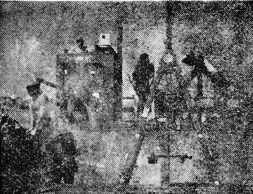 The RCL's "R" stands for ramp. Here, the ramp is raised and lowered by muscle-building hand operation.
The RCL's "R" stands for ramp. Here, the ramp is raised and lowered by muscle-building hand operation.
|
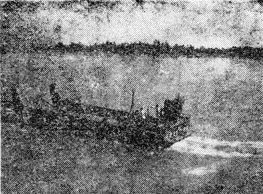 The RCL plows up (or maybe down) the river on a trial run. Air Forces, all at sea.
The RCL plows up (or maybe down) the river on a trial run. Air Forces, all at sea.
|
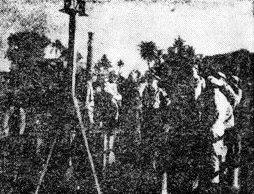 Maj. Gen. T. J. Hanley, Jr., commanding the ASC, inspects the first RCL's.
Maj. Gen. T. J. Hanley, Jr., commanding the ASC, inspects the first RCL's.
|
ASC Uses RCL To Ferry Goods Over I.B. Waters
ASC BASE, INDIA - Air Service Command in the I-B Theater has put into use an RCL (Ramp Cargo Lighter) which ferries goods over streams where roads are impracticable.
It will conserve time by ferrying trucks and cargo across bridgeless rivers, reducing the length of trips by hundreds of miles. As the Japs are pushed back it will project supply lines quickly into new regions.
POWERFUL ENGINES
The RCL is equipped with two powerful engines and can operate in shallow draft where other boats are helpless. Loading operations are simple due to its broad loading ramp.
ASC tackles the problem of launching its RCL's without a call for help. It recruited from the various engineering lines along the AAF strips a handful of specialists.
MOVE IN
These specialists moved in on the river front, picked the launching site and set to work. With a light crane to lift the parts of tonnage weight, they virtually simulated a miniature shipyard. With each succeeding RCL the line of assembly is being reduced.
Heading the crew was Lt. John Ben Jorn, formerly a marine superintendent in New York. Under him was S/Sgt. John A. Mutter, formerly a packing machine mechanic; S/Sgt. Charles E. Williams, a former welder; Sgt. Otto L. Brindley, ex-bartender, and Pfc. Lloyd D. Kirchgessner, a boat pilot in civilian life.
The ASC mariners are now referred to as the sea-bound soldiers.

|
Well chums, the Roundup has stepped in it again.
A couple of weeks back, this fishwrapper ran a little story giving a bouquet to a Navy unit maintaining an oxygen plant up in Assam. Cpl. Bob Bernstein, who wrote the article, pointed out what a fine job the dry-land sailors have been doing in supplying first-class oxygen for air crews going over The Hump.
Frankly, we considered it a nice story - giving praise where it was due and at the same time not hurting anyone's feelings. Unfortunately, we figured wrong.
The mailman brings a letter today, wherein Sgt. John M. Caren chides us for not spreading the credit to cover other oxygen units, adding that "our feelings are hurt."
Caren and his buddies, it seems, are on DS with a Service Squadron at APO 433, and while not actually denying that the Navy boys are doing a good job, they feel that it's high time they received their share of well-earned recognition.
The somewhat piqued sergeant points out that the Army also maintains a few well-equipped plants both in Assam and in China, where a "pretty good" quality and quantity of oxygen is produced.
And furthermore, says Caren, his oxygen team was not trained by the U.S. Navy (as Roundup's earlier story would indicate). As a matter of fact, the Army sent several enlisted men to New Hebrides and Guadalcanal to operate oxygen plants for the Navy.
'STRIPES' INSURANCE
ALONG THE LEDO ROAD - This is a story in which all the actors must necessarily remain anonymous. The scene is a medical outfit that has served many months in India and Burma and has faced some rough times.
Under the pressure of arduous schedules, stripes were being ripped off with regularity. The boys were concerned. After all there should be some way of guaranteeing that a man will continue to draw his sergeant's pay, even if he is reduced to private.
A few alert G.I.'s thought it over. Why not have stripes insurance! And so was born a unique institution that drove the last peg for a serene, secure Army career. The plan was simple too. A Private First Class was a small risk, so his premium was exceedingly light. A corporal paid more and the boys with a couple of rockers were assessed heavily, but after all they had more to lose.
Rank was not the only consideration in setting the premium scale, however. There were always good risks. You know, the guys who bowed to the brass and never snafued their jobs. But then there were the bad risks. The G.I.'s that were always loudly griping about the corned willie and noising it around that they didn't care what the captain said, they wouldn't fall-out for reveille. The insurance board weighed all cases and set the premium before writing a policy.
Nobody knows what happened to the G.I. Insurance Co., but it seems that with this last threat to soldier security removed, fewer and fewer stripes werefalling and the poor policy writers found themselves faced with bankruptcy. Just proves you can't make an honest dollar in the Army without some thoughtless guy crabbing the works.
KUKRI SWIPE REMOVES ONE EACH JAP NOB
MAUNGDAW - A Jap officer prides himself on his swordsmanship. He is schooled to use his traditional weapon in battle.
But the Kumaoni is clever, too, with his own weapon, the kukri. Just how clever he is Naik Partab Singh, of the 19th Hyderabad Regiment, showed when he met a Jap officer in single-handed combat in the Arakan.
During his battalion's attack on a Jap-held hill the Naik - part of a backstop party waiting to catch the fleeing enemy - spotted a Jap officer in a nullah.
He shouted at him to surrender. The Jap officer waved his sword above his head.
The Naik fired a couple of shots from his tommy gun to get his enemy's head down and then rushed across the open paddy.
The Jap swung his sword at the Naik as he rushed up. The Naik dodged the stroke, whipped out his kukri and with one blow almost decapitated his opponent.
"I didn't mean to kill him," said Partab Singh. "I wanted him as a prisoner."
ATC CORPORAL WINS PLAY WRITING PRIZE
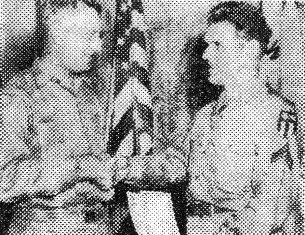 Cpl. Schoening receives $125 in war bonds from Brig. Gen. William H. Tunner, commanding the India-China Division,
ATC.
Cpl. Schoening receives $125 in war bonds from Brig. Gen. William H. Tunner, commanding the India-China Division,
ATC.
|
HQ., ICD ATC, CALCUTTA, INDIA - Cpl. Edward Schoening has been walking around recently with a broad smile on his face and the equivalent of rupees ample in his pocket. The reason - receipt of $125 in war bonds as first prize in a play writing contest conducted by the Writer's War Board.
His play, Monsoon Madness, depicting the life of a G.I. in India, was adjudged tops in competition open to servicemen throughout the world. The committee of judges included such celebrities as Dorothy F. Rodger, chairman.
Schoening, in civilian life, was employed by Paramount Studios and previously worked as a reporter and feature writer for the San Diego Sun. One of his earlier plays was produced by the Pasadena Community Playhouse. While stationed with the Sixth Ferrying Group of the ATC's Ferrying Division at Long Beach, Calif., Schoening helped write script for Wings Over the World, weekly NBC Blue Network show. He now serves in the ICD-ATC Judge Advocate's section.
Winning scripts in the contest Schoening copped will be published in book form for distribution to Army and Navy bases for production by soldiers and sailors.
SUPER SUPER-FORTS NOW BEING TESTED
WASHINGTON - A Washington publication given as a recent testimony before the House Appropriations Committee revealed that secret tests were underway on three long-range bombers that may dwarf the performance of the Super-Fort.
Doctor George Lewis, Director of Aeronautical Research, National Advisory Committee for Aeronautics, briefly mentioned all three, but said that the B-36 is "the largest airplane that has been attempted in this country."
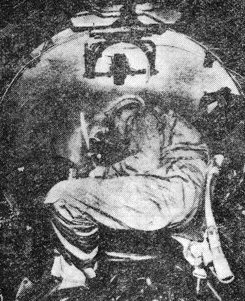 Beginning a bomb run, the bombardier sights his target through the telescope. Unitl the bomber is over the target,
control of the ship is in the bombardier's hands.
Beginning a bomb run, the bombardier sights his target through the telescope. Unitl the bomber is over the target,
control of the ship is in the bombardier's hands.
|
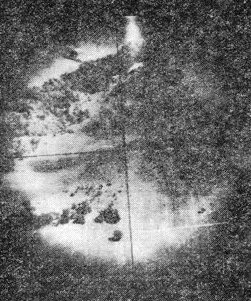 Above you see what the bombardier sees through his telescope. He holds the aircraft on the target, releases the
bomb load and says: "Let's now get our pants the hell out of here."
Above you see what the bombardier sees through his telescope. He holds the aircraft on the target, releases the
bomb load and says: "Let's now get our pants the hell out of here."
|
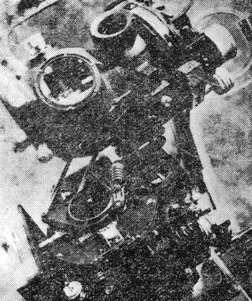 This is it. You, the Germans, or the Japanese are welcome to try and take this apart and make one of your own.
The Air Force says it will take you two years, minimum.
This is it. You, the Germans, or the Japanese are welcome to try and take this apart and make one of your own.
The Air Force says it will take you two years, minimum.
|
NORDEN'S BOMB SIGHT NO LONGER A SECRET
The Norden bomb sight, of which it has been said that "they ought to give the commisions to the bomb sights and leave the bombardiers at home," is no longer top secret.
The famous sight, invented by Carl L. Norden, Dutch inventor, recently went on public view in the United States, concurrent with awarding of the Holley Medal to the inventor by the American Society of Mechanical Engineers.
The public was permitted to look at the mechanism, small enough to fit in an overnight bag. It looks like an elaborate movie camera and contains more than 2,000 working parts, a complex body of mirrors, prisms, lenses, gears, cams, wires and bearings.
INTO ENEMY HANDS
It was inevitable that bomb sights would fall into enemy hands, as bombardiers shot down in enemy territory could not always be able to carry out their oath of destroying the sight before allowing it to come into possession of the enemy.
Even in 1943, Theodore H. Barth, president of Carl L. Norden, Inc., was not disturbed that possibly the Germans had examined a Norden sight.
"Even if they were given the blueprints," he said, "it would still take them a year and a half to tool up. Then they would have to teach people to use the tools. Then their troubles would begin. It is comparitively easy to build two or three. To get sizeable production takes a terrific effort."
JAP SKILL?
It is doubtful that the Japs have the technical skill to build it. Some of the secrecy surrounding the device which has contributed to U.S. defense for 20 years, was removed at the Army Air Forces bombardier school at Midland, Tex., in 1943. The decision to lift some of the secrecy from the sight came as a relief to bombardier stations. Previously only officers could handle it and it had to be locked up at night. After the 1943 decision, enlisted men could handle it, and it could be left in a plane under guard.
Three element make up the Norden bomb sight, (1) the sight, containing computing mechanism, sighting telescope, and vertical gyroscope, (2) the directional gyroscope, and (3) the automatic pilot. All are mounted in the bomber's nose behind plexiglass.
SECOND ELEMENT
The second element is mounted beneath the first and is usually fixed permanently in the plane, while the first is installed before each mission and removed when the mission is completed. A rubber eye-piece covers the telescope to prevent injury. Many an air cadet in training for the bombardier's seat sported a black eye in his training days because of the constant pressure of this eyepiece.
The third element, the automatic pilot, although not absolutely necessary, is a vital partner of the Norden bomb sight. By use of it, the bombardier can take control of the plane during the bombing run, which usually lasts about 25 seconds.
The plane, during a bombing run, must be absolutely horizontal or level with the ground and the plane must be maintained absolutely horizontal and level with any change of direction. This is the vital part which the automatic pilot contributes in enabling the bombardiers to lay their lethat eggs square on the target. If the plane is one infinitesimal angle off level flight when the bombs are dropped, the bombs will fall hundreds of yards off the target.
THEATER OPINION
Lt. Allen Scott of the 490th Bombardment Squadron (M) and Lt. Seymour Goldblum of the 7th Bombardment Squadron (H) say that the automatic pilot is many times as efficient and quick as the use of pilot directional indication, which must be worked out between pilot and bombardier when the automatic pilot is not used.
Scott and Goldblum say that the Norden bomb sight can be used to drop bombs at from 15 to 800-foot intervals and can be used at altitudes of from 200 to thouands of feet. Much use of the sight at low altitudes has been made in this theater.
Chief value of the Norden bomb sight and the automatic pilot is that when the bombardier lines up the cross hairs in the sight on the target, everything else becomes automatic with mechanical rapidity. Switch watch tolerances are crude compared to the mechanical perfection of this wizard instrument.
If it weren't for Norden and Newton, most bombardiers couldn't hit the ground - that's a bit of wisdom from a member of the Air Corps.

THE BATTLE OF MYITKYINA At Myitkyina today they lie at rest: Soldiers all were they who gave their best. Fought and died in mud and rain And never knew the sun again - For when night fell They found the jungle close to Hell. And each artillery shell Sang a melody of death, As they sat with caught-up breath Until the slow dawn came. Through sniper fire and filth In endless rain these brave fought on With all hope gone. Myitkyina has fallen. But its roads are dark with Yankee blood For gallant soldiers died In Burma's mud . . . And now they lie Silent, beneath an alien sky. Pvt. WADE D. HALL |
The Merrills Meet, But Depart Friends
ALONG THE LEDO ROAD - The hospital sack has been replaced by the cracker barrel, as convalescing Jungle Joes bide their time, swapping stories of heroism and prowess, humor and paradox. Happenings of months ago come to light for the first time.
Take the case of Pfc. Jimmy F. O'Malley, a personable Irishman with a flair for both remembering and relating jungle episodes. Patient at a large pill factory along the Ledo Road, he recalled the time when his own outfit, a field hospital, was set up at Ningam Sakan. This was many months ago when the sharp crackle of rifle fire was only a few miles ahead.
One day a jeep bounced and chugged up the crooked combat trail. A keen, sharp-eyed soldier stepped out of the vehicle. Nothing distinguished him from G.I.'s around the place. He called to a figure striding out of a nearby tent, "Which way to Yupbang?" The soldier responded quickly, "Haven't the slightest idea."
The fellow from the jeep quickly retorted, "You mean you don't know what's up ahead?" He got an equally snappy reply, "Why don't you find out where you're going before you start." Tempers mounted and the inquiring traveler asked, "Who are you anyway?" As confident as a man about to lay down four aces, the second soldier replied, "I'm Major Merrill of the Medics. Who are you?"
Without batting an eyelash, the other soldier said, "I'm General Merrill of the Infantry." A salute came up quickly and was returned. Sly smiles seemed to creep into both men's faces.But that isn't the end of the story. Sometime later Gen. Merrill suffered a heart attack at the front. He was removed to a field hospital nearby. The man who first attended him was Maj. Willis B. Merrill. They became fast friends. The general autographed the stock of his battle carbine and presented it to his namesake. Surely they must chuckle over that episode at Ningam.
Rotation Via Rhino
How to get rotated: Find yourself a healthy rhinoceros. Sell same to Stateside zoo, palming yourself off as its caretaker en route to the U.S. It's as simple as that.
At any rate, according to British service journal SEAC, that recipe worked for one Maj. Bill Sherwoord, U.S. Vet Corps, who recently came into posession of a rhino, tromping through Assam's jungles, which was owned by the Washington, D.C. zoo.
Obtaining official approval of his suggestion that the beast be shipped home, Sherwood and rhino are now awaiting a homebound boat.
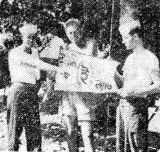
|
ASC BASE, INDIA - Members of an Air Service Command mobile machine shop unit have thrown modesty to the wind and announced to one and all that they're pretty hot potatoes when it comes to turning out the work and should be rewarded accordingly.
Pointing out their excellent record of maximum production, minimum absenteeism and no strikes, they recently presented themselves with a mock Army and Navy "E", a la Urdu.
ON PAT, JINX AND CO.
ADIEU TO SOME TROUPERS
The editors of Roundup some time ago prepared an essay on the entertainers, some from Hollywood, some from what is loosely called Broadway, who had visited China, Burma, and India to appear before the troops employed therein. The essay was splenetic and caused a bit of a row here and there.
In the midst of the row, another Hollywood troupe, headed by Pat O'Brien and Jinx Falkenburg arrived in India. To say that they were under the gun would be putting it mildly. About the first words they heard when they hit Karachi were to the effect that all Hollywood characters were, at the moment, being viewed with care.
It is now our pleasant duty to report, for the information of all concerned and for the record, a brief account of the tour this week completed by Pat, Jinx, Betty Yeaton, Jimmie Dodd, Ruth Carrell, and Harry Brown, and to say someting of the reception they were given and the reactions they invoked.
Firstly, they were committed to giving approximately 55 performances during the 50 days of their stay. Actually, they gave 81 formal shows and well over 100, including unscheduled hospital, day-room, and mess hall appearances.
Geographically, they gave of their talents and themselves from Karachi to Liuchow when the latter was within 22 miles of advancing Japanese columns. They made every single post, field, or station at which they had been scheduled and many where they were unexpected.
During their 50 days of hot, cold, rain, mud and fair weather they took two days off - one to visit the Taj Mahal and one for straightaway rest, asfter 10 days in China.
To describe their reception, as professionals and as people, one word, overworked out to the point, can be used - terrific!
 Most of you guys know that the above folks are Ruth Carrell, Harry Brown, Betty Yeaton, Pat O'Brien, Jinx Falkenburg,
and Jimmy Dodd, who have just wound up a tour of China, Burma, and India which was received by the loudest cheers
heard in these parts since the fall of Myitkyina.
Most of you guys know that the above folks are Ruth Carrell, Harry Brown, Betty Yeaton, Pat O'Brien, Jinx Falkenburg,
and Jimmy Dodd, who have just wound up a tour of China, Burma, and India which was received by the loudest cheers
heard in these parts since the fall of Myitkyina.
|
Speaking for the long-haired yucks who edit Roundup, we found them charming, friendly, and able. But what we think is beside the point.
There follow a few verbatim excepts from the many, many letters which have come to us since Pat, Jinx & Co. came to the East:
"We, on a forward-area air base in China, wish to submit a well-deserved plug for the Pat O'Brien troop... Rather than shun us as so many have before, they went out of their way to perform little extras for us... Jinx (God bless her) and adorable Betty Yeaton shared lunch with the lowly G.I.'s and signed hundreds of short-snorter bills between mouthfuls of hash... As for Pat O'Brien, Harry Brown, Jimmie Dodd, and Ruth carrell, too much cannot be said for their tireless efforts to complete the mission which they set out to perform."
Here's another, taken at random: "Although tired from their strenuous trip, the stars chose to stand around chatting with us, posing for pictures, or signing autographs, instead of the usual run to quarters. It wasn't long before we realized that we had among us a group of friends, a true example of the people we left at home."
Let's try another: "This is an unsolicited, non-syndicated tribute to an overseas show. O'Brien and Jinx Falkenburg . . They are the most real people we have seen since we left the U.S. 18 months ago . . The whole troupe spent all hours of their stay here with the G.I.'s . . Pat O'Brien endeared himself to every fellow at this jungle airstrip."
We could go on with this for all the white space on the page. What you see above will give you a rough idea. We have not received on dissenting vote and we don't expect to.
Lest it be suggested that we have overlooked anyone, we'd like to point out that right now there are five other groups of USO entertainers in the theater, going through the same tough mill: USO Troupe 342, a cracker-jack Negro outfit; USO 289, Benny Meroff & Co.; Sketch artist Albert lake; USO 269, a five-girl gang; and USO 418, the ball players, Dixie Walker, Paul Waner, Luke Sewell, and writer Arthur Patterson.
And there we are. pat and Jinx and their company are now on their way home. And for their Godspeed, we are going once more to the soldiers in the field for another direct quote from a soldier's letter:
"In leaving, they left behind thousands of friends, all soldiers, who'll be pulling for them when we're all back home, and they will still be entertaining millions of Americans over there. So, for the thousands you leave behind in Burma, Jinx and Pat, Ruth and Jimmie, Betty and Harry, I want to say thanks a million for coming our way, and we'll never forget any of you. It was swell."
The C.B.I. Roundup is a weekly newspaper of the United States Army Forces, published by and for the men in China, Burma, and India, from news and pictures supplied by staff members, soldier correspondents, the United Press, OWI, and the Army News Service. The Roundup is published Thursday of each week and is printed by The Statesman in New Delhi and Calcutta, India. Editorial matter should be sent directly to Capt. Floyd Walter, Hq., U.S.F., I.B.T., New Delhi, India, and should arrive not later than Sunday in order to make that week's issue. Pictures must arrive by Saturday and must be negatives or enlargements. Stories should contain full name and organization of sender. Complaints about circulation should be sent directly to Lt. Boyd Sinclair, Hq., U.S.F., I.B.T., New Delhi, India. Units on the mailing list should make notification of any changes in personnel strength or any change of APO.

DECEMBER 14, 1944
Original issue of C.B.I. Roundup shared by CBI veteran Tom Miller
|
a member of the team. The picture was published in another, unknown December 1944 issue. |
Copyright © 2006 Carl Warren Weidenburner
TOP OF PAGE PRINT THIS PAGE ABOUT THIS PAGE SEND COMMENTS
PREVIOUS ISSUE CLOSE THIS WINDOW NEXT ISSUE
